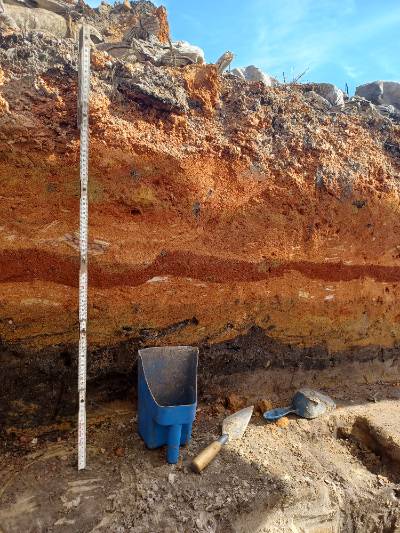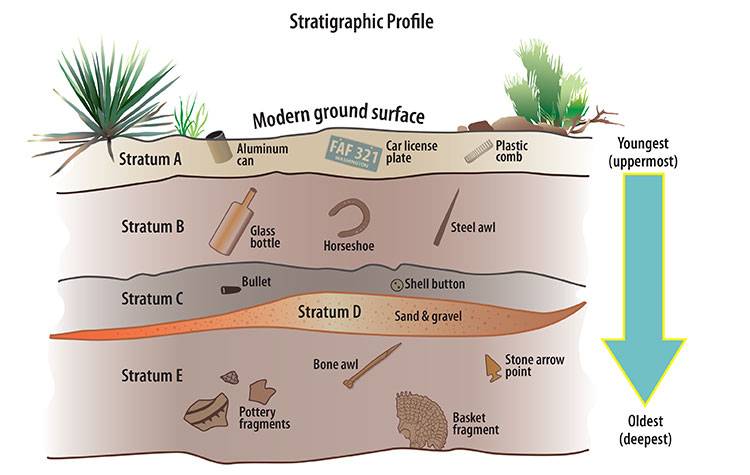The Archaeologist’s Toolkit: What is Stratigraphy?
Posted on November 30, 2022 by Chelsea Cook
When you were growing up, did you ever want to dig a tunnel to China? Well, you won’t reach China, but that tunnel could transport you to a different time period. For archaeologists, excavation is like a time machine; the deeper we dig, the further back in time we go. How is this possible?
Over time, sediment, soil, and debris accumulate and layer on top of each other. These layers of soil are referred to as “stratigraphy.” Stratigraphy is important because it helps date different components of a site. Stratigraphy draws on the geologic concept of the law of superposition, which states if rock layers are undisturbed, the oldest rocks will be found at the bottom and the youngest rock will be found at the top. The same rule applies to layers of soil.

Soil layers from the I-10 Mobile River Bridge Archaeology Project. The orange and red layers are clay fill that was brought in during the construction of I-10.
The best way to demonstrate the law of superposition is to think of it like a laundry basket. For instance, I do my laundry every Sunday. This means every Monday morning my hamper is empty and continues to fill up throughout the week. Each day I come home after a long day, take a shower, and throw my dirty clothes in the hamper. This usually occurs throughout the whole week, sometimes embarrassingly longer in my case. When Sunday finally comes around, my clothes from each day has layered on top of each other, much like strata do in sedimentary rock. The clothes that I have worn most recently, say my outfit from Saturday, will be towards the top of the hamper. However, the deeper I dig into the hamper, the further back in the week I will go until I eventually reach the first outfit of the week. Monday’s outfit is at the bottom of the hamper because it is the oldest. Strata work in the same way!
Each individual stratum, or soil layer, can be differentiated based on a variety of factors, such as soil color or texture. As archaeologists dig, we work carefully to spot any changes in the soil. This allows us to decipher different strata and ensures we isolate artifacts found in each individual layer. We make a corresponding map of the stratigraphy in profile view to document these layers.

An example of a stratigraphic profile, courtesy of Crow Canyon Archaeological Center.
Stratigraphy allows us to relatively date each layer of soil based on the artifacts found in each stratum. This helps us understand the chronological sequence of events. For instance, in the image above, an item found in Stratum E, such as a bone awl, would be considered older than an item found in Stratum B, such as a horseshoe. When we find an artifact, we must record its provenience, or the exact location where it was found. This includes both the vertical location, or how deep it was found, as well as the horizontal location, or where in the excavation unit it was located.
This record is crucial because it provides context for the artifact when it is brought back to the lab for analysis. Context is the relationship that artifacts have to their surroundings and to the other artifacts found at the site. This information can help provide a date for when the site was occupied and the function or meaning of the artifacts recovered from the excavation. When an archaeologist removes an artifact without recording its location, its context is lost forever, and the artifact loses its value. Provenience and context are vital for understanding how people in the past lived their day to day lives.
This post was written by Anthropology Student Chelsea Cook as part of the Archaeologist’s Toolkit series. Learn more about other archaeological methods and concepts in her other posts:
Further Reading about Stratigraphy:
The Archaeologist’s Toolkit: What Is Archaeology?
Crow Canyon Archaeological Center: Archaeological Dating
Society for American Archaeology: What Do Archaeologists Do?
Green River Preserve: Stratigraphy and Provenience in Archaeology


